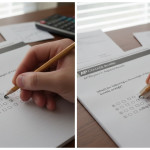Why breaking problems into pieces will change the way you do SAT Math
When you open an SAT Math section, some questions look like neat little puzzles and others look like scrambled luggage — too many parts, numbers, and steps all lumped together. The secret that separates rushed guesses from clean, confident answers isn’t magic; it’s a skill: problem decomposition. This is the habit of breaking a complex problem into smaller, manageable tasks you can solve one at a time. For the SAT, it’s a game-changer.
What problem decomposition actually means
At its core, decomposition is reducing cognitive load. Instead of trying to juggle an entire multi-step problem in your head, you identify subproblems, solve each in sequence, and combine results. Think of it like assembling a piece of furniture: instead of trying to build the whole thing blind, you follow steps that create subassemblies, then connect them.
Why it matters on the SAT
- Clarity: Smaller steps reduce mistakes and misreadings.
- Speed: A clear plan often beats trial-and-error.
- Partial credit thinking: Even though SAT is multiple choice, decomposition increases the chance of finding an intermediate value you can use to eliminate choices.
- Transferable skills: The method helps with algebra, geometry, functions, and word problems — in short, almost everything on SAT Math.
How to spot opportunities for decomposition
Not every problem needs formal decomposition. But you’ll often profit from it when you see:
- Multiple relationships or equations that can be handled separately (for example, a system combined with a functional expression).
- Complex expressions that simplify under substitution.
- Geometric figures where you can partition areas, angles, or lengths.
- Word problems that mix rates, ratios, or phases — separate the story into temporal or conceptual chunks.
Four decomposition techniques that work well on SAT Math
- Isolate and substitute: Solve one equation or expression for a quantity, then substitute into the other. This reduces variables and algebraic clutter.
- Work backwards: Start from answer choices or the desired final expression and see what must be true at earlier steps.
- Simplify then operate: Reduce fractions, cancel common factors, or factor polynomials before expanding — often the messy middle cancels out.
- Draw and partition: In geometry, divide complex figures into triangles, rectangles, or sectors you know how to handle.
Worked example: Decomposing an SAT-style algebra problem
Let’s walk through a realistic example and use decomposition to make it straightforward.
The problem
Suppose a function f satisfies f(x + 1) = 2f(x) + 3 for all real x, and f(0) = 1. What is f(3)?
Raw approach (what many students try)
Plugging in x = 0 to get f(1), then x = 1 to get f(2), then x = 2 to get f(3). That works, but the process feels repetitive and you might make an arithmetic slip. We can decompose the recurrence to a compact expression and compute fewer intermediate values.
Decomposed approach: identify a pattern
- Step 1: Write the recurrence for a few consecutive values to see structure.
- Step 2: Try to express f(n) in terms of f(0) using algebraic manipulation or iteration formula recognition.
Work it out: f(1) = 2f(0) + 3 = 2(1) + 3 = 5. f(2) = 2f(1) + 3 = 2(5) + 3 = 13. f(3) = 2f(2) + 3 = 2(13) + 3 = 29.
But decomposition offers a compact view. Recognize the recurrence is linear non-homogeneous. If you look for steady-state behavior, suppose there’s a constant c where c = 2c + 3, which doesn’t exist, but a particular solution is constant; instead, standard technique yields a closed form f(n) = A * 2^n + B. Using decomposition, you can find A and B quickly from initial conditions. For the SAT, though, often iterating three times as above is easiest; decomposition is about choosing the right small plan rather than always using the heaviest algebra.
Worked example: Geometry with partitioning
Geometry on the SAT rewards drawing and chopping shapes into known bits.
The problem
A right triangle has legs of length 6 and 8. A rectangle is inscribed so that one side of the rectangle lies along the hypotenuse and the opposite corners touch the two legs. What is the area of the rectangle?
Decompose the figure
- Step 1: Recognize the original triangle is 6-8-10.
- Step 2: Use similarity. If a rectangle’s top side lies on the hypotenuse, the two small triangles left above the rectangle are similar to the big triangle.
- Step 3: Let the rectangle have height h (distance from hypotenuse down to the right angle). Express rectangle dimensions in terms of h using ratios from similar triangles, then compute area = base * height.
This decomposition avoids messy coordinate algebra. By isolating the rectangle and the two similar triangles, we convert the geometry into proportions — a small, reliable problem.
Pattern recognition: when substitution shines
Substitution is one of the most practical decomposition tools on the SAT. Complicated algebraic expressions often collapse when you name a repeated subexpression and replace it with a single symbol.
Example
Solve for x: sqrt( (x+1)/(x+4) ) + sqrt( (x+4)/(x+1) ) = 5/2. On sight, two messy radicals are intimidating.
Decompose with substitution
- Let t = sqrt( (x+1)/(x+4) ). Then the second radical is 1/t because the expressions are reciprocals.
- The equation becomes t + 1/t = 5/2. Multiply both sides by t to get t^2 – (5/2) t + 1 = 0, a quadratic in t.
- Solve the quadratic, then back-substitute to find x. The heavy algebra disappears into a small quadratic — much easier to manage under timed conditions.
Table: A simple illustration of decomposition benefits (hypothetical)
The table below shows a simulated comparison between a direct, non-decomposed method and a decomposition-based approach on typical multi-step SAT Math problems. These numbers are for illustration — they represent plausible effects of using decomposition consistently.
| Metric | Direct Method (no decomposition) | Decomposition Method |
|---|---|---|
| Average time per problem | 3.5 minutes | 2.2 minutes |
| Average steps written | 7 steps | 4 steps (clear sub-results) |
| Estimated error rate | 18% | 8% |
| Confidence in answer | Medium | High |
Why this works: decomposition reduces redundant work and organizes thinking. The numbers above are illustrative, but they mirror the real effect many tutors and students report: fewer errors, faster resolution, and higher confidence.
Practical strategies to turn decomposition into a habit
Habits form through repetition with reflection. Here are concrete practices to make decomposition automatic under test pressure.
Daily practice routine (30–60 minutes)
- Warm-up (5–10 minutes): Do three quick problems that reward pattern spotting (e.g., a short algebraic manipulation, a fraction simplification, a quick geometry fact).
- Focused session (20–30 minutes): Pick one multi-step problem type — systems, recurrences, area/volume, or probability — and solve 4–6 problems, explicitly writing sub-steps. Practice naming subexpressions and drawing partitions.
- Reflection (5–10 minutes): Write down the decomposition you used and how it simplified the work. Note one improvement to try next time.
Timed drills
Practice breaking a problem into two or three mini-tasks and timing each task. For example, “Task 1: rewrite and simplify” (45–60 seconds); “Task 2: solve an isolated equation” (60–90 seconds); “Task 3: combine results and check” (30–60 seconds). This helps you manage both problem complexity and overall pacing.
Use answer choices as a decomposition tool
When in doubt, work backwards from an answer choice. Plugging a candidate into smaller subexpressions can quickly validate or eliminate answers. It’s a decomposition tactic because you treat the problem as “does this candidate satisfy these independent parts?”
Common pitfalls and how decomposition avoids them
- Pitfall: Trying to do everything mentally. Fix: Write intermediate results — a small note reduces memory load and prevents sign errors.
- Pitfall: Overcomplicating the algebra. Fix: Substitute a repeated expression or factor early.
- Pitfall: Losing the structure of geometry problems. Fix: Draw additional lines — altitudes, medians, or parallel segments can split the figure into known shapes.
- Pitfall: Panicking under time pressure. Fix: Use a two-step decomposition: identify what you need to find, then list 1–3 smallest tasks that produce it. Execution becomes calmer and more accurate.
How tutoring helps you learn decomposition faster
Learning to decompose well is not only about practicing problems — it’s about getting feedback on how you slice them. That’s where personalized tutoring really shines. A tutor can:
- Spot thinking patterns that lead to wasted steps and suggest alternative decompositions.
- Offer tailored study plans that focus practice on the problem types where you lose the most time.
- Provide 1-on-1 guidance to model decomposition live, then watch you replicate it with immediate correction.
For example, Sparkl’s personalized tutoring combines expert tutors with AI-driven insights to identify recurring errors and recommend specific decompositional strategies. That combination accelerates progress because you practice the right kinds of problems with targeted feedback rather than repeating the same mistakes.
Practice problems to build decomposition fluency
Below are a few targeted practice problems. Try them using the decomposition approaches discussed, time each sub-step, and then reflect on what became easier.
- Algebra: Solve for x: (x^2 – 5x + 6) / (x – 2) = 4. Decompose by factoring numerator before dividing.
- Functions: If g(x) = 3x – 2 and h(x) = x^2 + 1, find g(h(2)). Decompose by computing h(2) first, then g of that result.
- Geometry: A trapezoid has bases 10 and 6 and area 64. Decompose by slicing into a rectangle and two right triangles to find height.
- Probability: Two events are sequential with conditional probability. Write the joint probability as a product of simpler conditional pieces.
How to check your decomposition
- Does each sub-step produce a value or relationship you can use next? If not, refine the split.
- Would another decomposition (e.g., different substitution or drawing) reduce steps further?
- Test edge cases or plug known values to validate intermediate expressions quickly.
From practice to performance: integrating decomposition under timed conditions
Making decomposition automatic requires simulated test conditions. Here’s a mini plan to integrate decomposition into your SAT routine over four weeks.
- Week 1 — Awareness: For every multi-step problem, write down three possible decompositions. Choose one and solve. Note the best decomposition in a log.
- Week 2 — Speed: Time each sub-step and aim to reduce total time by 10–20% while keeping accuracy high.
- Week 3 — Variation: Mix problem types (algebra, geometry, functions) and practice choosing the right decomposition quickly.
- Week 4 — Simulation: Take two timed practice sections, forcing yourself to sketch decompositions in the first 30 seconds for each multi-step question. Review errors immediately and adjust your decomposition patterns.
Working with an experienced tutor during this process can compress the learning curve. Sparkl’s approach — pairing 1-on-1 guidance with tailored study plans and AI-driven insights — can help you identify which decompositions give the biggest score returns for your current level and where to focus your practice time.
Real-world thinking: why decomposition matters beyond the SAT
Decomposition isn’t just a test trick. It’s how engineers design systems, how scientists isolate variables in experiments, and how professionals structure complex projects. Learning to break problems into parts builds analytical habits that pay dividends in college courses and careers. The SAT simply gives a concentrated environment to sharpen that skill.
Final tips — small habits that compound
- Always write a one-line plan when you see a multi-step question: e.g., “1) Substitute t = …; 2) solve quadratic; 3) check domain.”
- Use the answer choices as checkpoints — plug them into parts of the problem before committing to full algebra.
- Keep a decomposition notebook: record problems where a particular partition saved time or prevented a mistake. Revisit these when you’re stuck on similar future problems.
- Practice under timed conditions but also practice slow. The fastest thinkers are usually those who practiced clarity at a slower speed first.
Closing: Think small, test big
On the SAT, where every second and every point counts, problem decomposition gives you structure, reduces mistakes, and boosts confidence. It turns intimidating questions into a series of short challenges you know how to solve. If you pair deliberate practice with guided feedback — for example through personalized tutoring that offers 1-on-1 guidance, tailored study plans, and focused skill-building — you’ll internalize these habits faster and more reliably. Whether you’re working independently or getting help from experts, practicing decomposition is one of the highest-return habits you can build for SAT Math.


Keep slicing problems into tidy pieces, practice the plan, and watch your accuracy — and score — climb. Good luck — you’ve got this.






















No Comments
Leave a comment Cancel